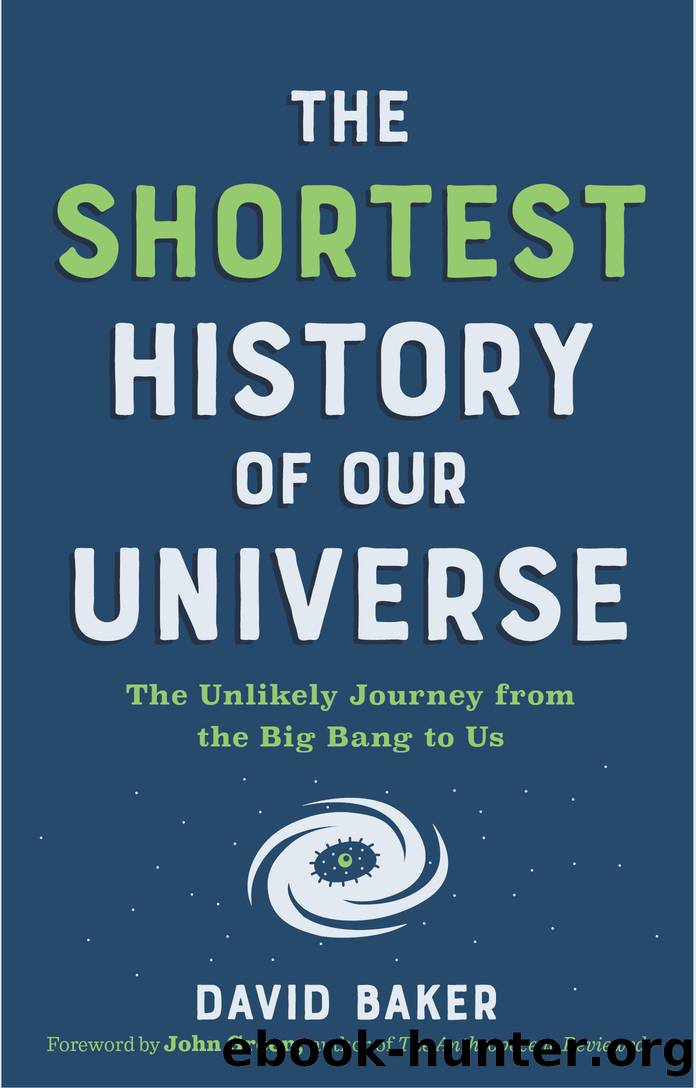The Shortest History of Our Universe by David Baker

Author:David Baker
Language: eng
Format: epub
ISBN: 9781615199747
Publisher: The Experiment
Published: 2023-05-15T00:00:00+00:00
It Takes a Village . . .
Putting the famines, pestilence, and diseases that could make you shit yourself to death aside, these early farming societies were able to support way more people per square mile than the foraging cultures from which they emerged. The result was an acceleration of collective learning and a resulting rise of complexity.
In the foraging era, the center of gravity for a society was the family. Kinship was the primary mode of maintaining governance, and alliances between groups were maintained by ritualized intermarriage. The rise of agriculture added another layer to this societal complexity. The farm still consisted of the family, with each member engaged in daily duties for subsistence, and with intermarriage occurring between families on neighboring farms. But the social life of the agrarian society converged in the village, a place populated by a few hundred people who would gather to exchange things (agricultural goods, tools, and information) and engage in the governance of affairs that affected the wider community (crop yields, problems arising from the weather, the possible threat of raiders, and the resolution of disputes between families). Villages were also places where grains could be stockpiled in case the wider community was struck by famine. There even appears to have been the development of religion in the Early Agrarian Era, with villages partaking in increasingly elaborate burial traditions for their dead. These burials yield an array of jewelry and other decorative items, which may well have denoted status, and thus the increasing sophistication of hierarchies.
In terms of violence, the majority of it doubtless remained interpersonal, as in the foraging era. But with sedentism and the introduction of land claims, crop yields, and possession of livestock came conflict over property. This may have manifested itself in either thievery by neighbors or land disputes between them that were arbitrated by the wider community.
There was also the new problem of raiders: neighboring cultures (either other sedentary farmers or non-sedentary foragers) who would rampage across a farming region, taking crops, livestock and tools, and perhaps even kidnapping women and children. The earliest agrarian settlements, such as the village at Abu Hureya in Mesopotamia, which housed sedentary farmers 10,000 years ago (8000 bce), donât show much sign of defensive apparatuses. But as the agrarian era dragged on, farming communities begin to build walls, ditches, and watchtowers around local villages. One of the most impressive examples of this is the village of Banpo in China, which lasted from 7,000 to 5,000 years ago (5000 to 3000 bce), and where all the dwellings were clustered in a group behind a wall which was surrounded by a ditch.
Download
This site does not store any files on its server. We only index and link to content provided by other sites. Please contact the content providers to delete copyright contents if any and email us, we'll remove relevant links or contents immediately.
The Lonely City by Olivia Laing(4750)
Animal Frequency by Melissa Alvarez(4395)
All Creatures Great and Small by James Herriot(4233)
Walking by Henry David Thoreau(3894)
Exit West by Mohsin Hamid(3778)
Origin Story: A Big History of Everything by David Christian(3649)
COSMOS by Carl Sagan(3554)
How to Read Water: Clues and Patterns from Puddles to the Sea (Natural Navigation) by Tristan Gooley(3409)
Hedgerow by John Wright(3276)
The Inner Life of Animals by Peter Wohlleben(3259)
How to Read Nature by Tristan Gooley(3249)
How to Do Nothing by Jenny Odell(3232)
Project Animal Farm: An Accidental Journey into the Secret World of Farming and the Truth About Our Food by Sonia Faruqi(3178)
Origin Story by David Christian(3148)
Water by Ian Miller(3128)
A Forest Journey by John Perlin(3027)
The Plant Messiah by Carlos Magdalena(2883)
A Wilder Time by William E. Glassley(2818)
Forests: A Very Short Introduction by Jaboury Ghazoul(2790)
